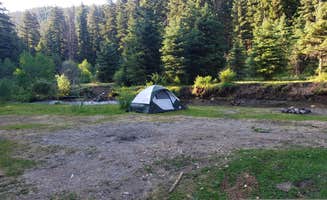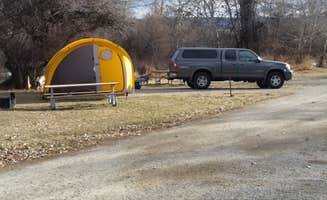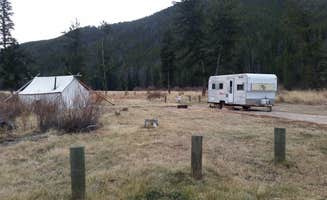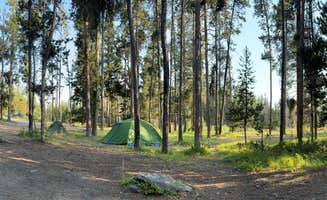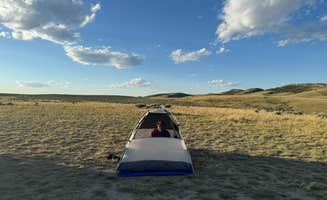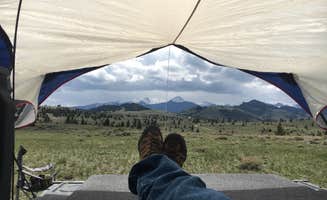Primitive camping opportunities near Butte, Montana range from dispersed sites along forest roads to established campgrounds with basic facilities. The area sits at elevations of 5,500-6,500 feet where summer temperatures typically peak in the 70s-80s F during the day and drop into the 40s at night. Winter camping remains possible at lower elevations with proper cold-weather gear as temperatures can fall well below freezing.
What to do
Hiking access: Humbug Spires Wilderness Study Area offers a 6-mile one-way hiking trail from its trailhead. "This location is not a campground, it is the trail head for Humbug Spires and wonderful 6 mile one way hiking trail. The trail head is small with not much room for vehicles," notes reviewer Dexter I.
Fishing opportunities: Salmon Fly provides direct river access with concrete boat launches. "Salmon Fly Fishing Access Site is a beautiful small campground along the Big Hole River. The site has six campsites all nice spread apart from each other, and a decent size day use area," writes one camper.
Town exploration: Camp at Pipestone RV Park & Campground for easy access to nearby communities. "We pulled in late at night and found a site off the main road. It was easy to set up, only saw two other sets of people," reports Aisha T.
What campers like
Privacy between sites: Multiple camping areas offer secluded spots away from neighboring campers. At Homestake Lake Camp, "down the various 2 tracks, there are hidden sites that afford some shade and privacy," according to Tee C.
River proximity: Campsites along the Big Hole River provide direct water access. At Maidenrock, "Access to the river is through a break in the fence along the shore of the Big Hole river," notes Dexter I.
Cell coverage: Unlike many remote camping areas, some dispersed sites maintain reliable connectivity. At Homestake Lake Camp, one camper reports getting "3-4 bars LTE of Verizon here," making it suitable for those needing to stay connected.
What you should know
Campground closures: Some previously established campgrounds now function as dispersed camping areas with minimal facilities. Deerlodge National Forest Ladysmith Campground reviewer Dexter I. states: "Ladysmith Campground is no longer a campground. After years of little use and then the pine beetle attack on the trees, the forest service cleared out the dead trees and everything else in the campground."
Limited facilities: Most primitive tent camping near Butte requires self-sufficiency. "No water or trash service is available," notes a Salmon Fly reviewer, reflecting conditions at many area sites.
Seasonal operation: Campground availability varies by season with higher elevation sites typically closed in winter. Deerlodge National Forest Orofino Campground operates from "late May to mid September," according to site information.
Tips for camping with families
Look for established sites: For families, campgrounds with basic amenities provide more comfort. "Sites have gravel parking pads, metal fire rings and picnic tables, along with nice grass areas to set up a tent," notes a reviewer about Salmon Fly.
Riverside locations: Sites near water offer natural entertainment for children. At Deerlodge National Forest Orofino Campground, "The campground has plenty of shade from its large trees," writes Dexter I., providing protection from summer sun.
Group camping options: Some locations feature designated group sites. "Orofino campground is a small campground with 11 sites, but it also has a second half across the road which has two large family/group camps and a Day Use area with a large pavilion," explains a camper.
Tips from RVers
Limited RV access: Most primitive sites near Butte accommodate smaller vehicles only. At Salmon Fly, one RVer notes: "A little short on the length but okay for our 29'," indicating size restrictions.
Basic overnight parking: For self-contained RVs, some fishing access sites provide simple overnight stops. At Jerry Creek Br Fish Access, reviewer Kaitlyn L. states: "If you were self contained and just looking to get off the 15 for the night then it would work for ya. Otherwise it's just a big boat parking lot for the river."
No hookups available: RVers should prepare for dry camping with no electrical, water or sewer connections at any primitive sites. Most locations require RVers to be fully self-contained with adequate water supplies and waste storage capacity.


